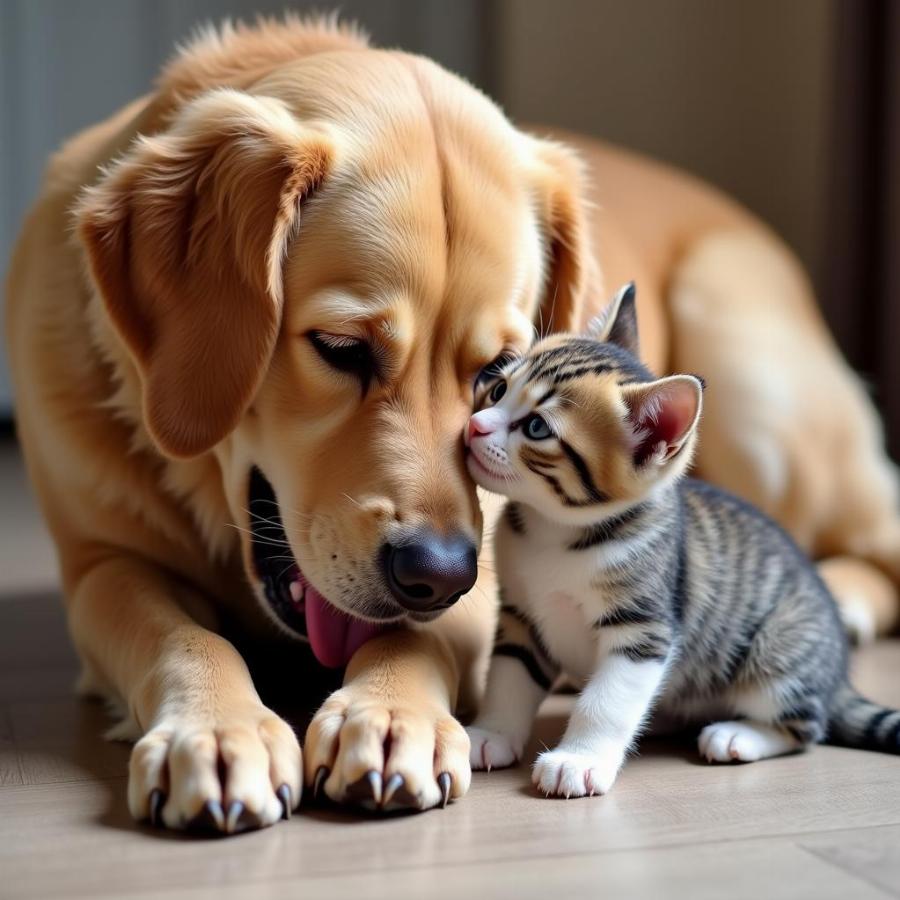The phrase “sucker punch doga cat” might seem confusing at first. After all, it combines three distinct animals: a dog, a cat, and a “doga” (which likely refers to the Dogue de Bordeaux breed, known for its powerful build). You might be picturing a bizarre multi-species brawl, but the reality is far less dramatic.
The truth is, the term “sucker punch doga cat” is likely a nonsensical string of words that has emerged from the depths of the internet. It’s not a recognized phrase in the dog breeding world, animal behavior studies, or any other legitimate field.
However, this seemingly nonsensical phrase offers us an opportunity to discuss a very real and important topic: responsible pet ownership and understanding animal behavior.
Why Misunderstandings About Animals Happen
While the “sucker punch doga cat” might be a fictional concept, misunderstandings about animals, especially between different species, are common. Here are some reasons why:
- Anthropomorphism: We often project human emotions and motivations onto animals. This can lead to misinterpretations of their actions. For example, a dog wagging its tail isn’t always happy; it can also be a sign of anxiety or agitation.
- Lack of Knowledge: Many people lack basic knowledge about different dog breeds, cat behavior, and the complexities of interspecies interactions.
- Sensationalism: The internet is rife with exaggerated stories and clickbait headlines about animals, which can perpetuate myths and misconceptions.
 Dog and Cat Playing Together
Dog and Cat Playing Together
Fostering Harmony Between Dogs and Cats
While dogs and cats have a reputation for not getting along, they can actually coexist peacefully and even become the best of friends. Here are some tips for fostering a harmonious multi-species household:
- Gradual Introductions: Never force interactions between a new dog and cat. Start with separate spaces and allow them to acclimate to each other’s scents gradually.
- Supervised Interactions: When you do introduce your dog and cat, keep initial interactions short and supervised. Offer positive reinforcement, such as treats and praise, for calm behavior.
- Provide Separate Resources: Ensure your dog and cat each have their own designated food and water bowls, litter boxes, and resting areas. This helps prevent resource guarding and territorial behavior.
Understanding Dogue de Bordeaux Temperament
Since the original search term likely involved the Dogue de Bordeaux breed, it’s worth discussing their temperament. Dogues are powerful dogs with a strong guarding instinct. While generally loyal and affectionate with their families, they require early socialization and consistent training to manage their protective nature.
Seeking Accurate Information
When encountering unusual phrases like “sucker punch doga cat” online, it’s essential to approach them with a critical eye. Always rely on reputable sources of information about animals, such as:
- Veterinarians: Your veterinarian is your primary resource for information about your pet’s health and behavior.
- Certified Animal Behaviorists: These professionals can offer guidance on addressing specific behavioral issues in dogs and cats.
- Reputable Breed Organizations: Organizations like the American Kennel Club (AKC) provide breed-specific information and resources.
Conclusion
While the phrase “sucker punch doga cat” might be a head-scratcher, it highlights the importance of responsible pet ownership and seeking accurate information. By understanding the nuances of animal behavior and fostering positive relationships between our furry companions, we can create happy and harmonious homes for all.
FAQs About Dogs and Cats
Q: Can dogs and cats really be friends?
A: Absolutely! While they have different communication styles, dogs and cats can learn to live together peacefully and even form strong bonds.
Q: How can I tell if my dog and cat are playing or fighting?
A: Playful interactions usually involve relaxed body language, open mouths with panting, and playful bows. Aggressive behavior includes hissing, growling, pinned-back ears, and tense body postures.
Q: What should I do if my dog chases my cat?
A: It’s important to redirect this behavior with training. Teach your dog a reliable “leave it” command and provide plenty of mental and physical stimulation to prevent boredom-induced chasing.
Have More Questions?
Looking for more insights into the fascinating world of dogs and cats? Check out these other articles on our website:
- [Link to article about introducing dogs and cats]
- [Link to article about Dogue de Bordeaux care]
- [Link to article about common dog and cat behavior issues]
Beaut Dogs
Beaut Dogs is your trusted source for all things canine! We provide expert advice, tips, and resources to help you navigate the joys and responsibilities of dog ownership. From breed information to training tips and health advice, we’re here to support you every step of the way.
For personalized guidance and answers to your specific questions, don’t hesitate to contact our team at [email protected]. Let Beaut Dogs help you create a fulfilling and loving relationship with your furry best friend.